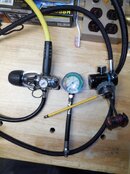Newbie Post, My 12th CCR, (Shakedown) Dive
As a new Choptima diver who had not dived it in 54 days, I joined two CCR divers for a shakedown dive. Ergo, check and improve performance under controlled, safest, conditions in preparation for more demanding diving.
During the dive I again noted the O2ptima Nomad LS with chest mount rebreather is very stable, roll resistant, with scrubber, dilutent, and pony bottle under the diver and the buoyancy on top, but slant from my body increasing drag and snag potential. Even with harness straps loose, the rig is self-righting like a sailboat, thus eliminating the stability problem I hated with doubles. Trim and buoyancy were excellent with 2 pounds placed in the top position of the Nomad’s back weight strap (200-pound diver in a 3mm wetsuit, booties, and jet fins, with three handheld lights). The Choptima’s modular type design facilitated positioning the dilutent, pony bottle, and fins at the water’s edge, spreading the weight out over two trips. Superior stability and portability sold me on the Choptima. Unlike my previous mask, my new (kudos to) Diverite tear-shaped mask allowed me to keep the HUD constant in my field of view and to easily pinch my nose. My previous three masks would not. To do: tighten shoulder straps and reposition the hardware on the belt and crotch strap. Work on aligning clip-on cylinders with my body. Record weight parameters in my logbook.
The used dilutent Din regulator that I bought with the Choptima came unscrewed because of lack of lubrication and maintenance. I corrected and will be more vigilant in the future. Several of the low-pressure hoses were too long creating a snag hazard and making it difficult to rapidly check the routing of the hoses. I installed the optimum length.
My plastic dilutent pressure gauge, on a 6-inch hose, was relatively fragile, and a snag hazard. I have installed shorter hoses and two pressure gauges that screw directly into the first stages of the dilutent and pony bottles to streamline my profile and keep the mistress happy.
My gear organization sucked. My save a dive and rebreather support boxes were temporally lost in transit among the four vehicles we used for transport. Now my equipment is in two mesh dive bags.
Like an exotic mistress, a rebreather is less likely to kill you if you treat it well and spend money on it. Buying a buoyancy compensator that was designed to integrate with the Choptima was an excellent use of money. Although they were functioning perfectly on all 11 of my dives, the Diverite manual, directed that it was time to replace the O2 sensors; I value my life too highly to do anything else. One new sensor appeared to be defective until I calibrated it. This is not mentioned in the book, so it gave me pause.
Ready for the Keys!
As a new Choptima diver who had not dived it in 54 days, I joined two CCR divers for a shakedown dive. Ergo, check and improve performance under controlled, safest, conditions in preparation for more demanding diving.
During the dive I again noted the O2ptima Nomad LS with chest mount rebreather is very stable, roll resistant, with scrubber, dilutent, and pony bottle under the diver and the buoyancy on top, but slant from my body increasing drag and snag potential. Even with harness straps loose, the rig is self-righting like a sailboat, thus eliminating the stability problem I hated with doubles. Trim and buoyancy were excellent with 2 pounds placed in the top position of the Nomad’s back weight strap (200-pound diver in a 3mm wetsuit, booties, and jet fins, with three handheld lights). The Choptima’s modular type design facilitated positioning the dilutent, pony bottle, and fins at the water’s edge, spreading the weight out over two trips. Superior stability and portability sold me on the Choptima. Unlike my previous mask, my new (kudos to) Diverite tear-shaped mask allowed me to keep the HUD constant in my field of view and to easily pinch my nose. My previous three masks would not. To do: tighten shoulder straps and reposition the hardware on the belt and crotch strap. Work on aligning clip-on cylinders with my body. Record weight parameters in my logbook.
The used dilutent Din regulator that I bought with the Choptima came unscrewed because of lack of lubrication and maintenance. I corrected and will be more vigilant in the future. Several of the low-pressure hoses were too long creating a snag hazard and making it difficult to rapidly check the routing of the hoses. I installed the optimum length.
My plastic dilutent pressure gauge, on a 6-inch hose, was relatively fragile, and a snag hazard. I have installed shorter hoses and two pressure gauges that screw directly into the first stages of the dilutent and pony bottles to streamline my profile and keep the mistress happy.
My gear organization sucked. My save a dive and rebreather support boxes were temporally lost in transit among the four vehicles we used for transport. Now my equipment is in two mesh dive bags.
Like an exotic mistress, a rebreather is less likely to kill you if you treat it well and spend money on it. Buying a buoyancy compensator that was designed to integrate with the Choptima was an excellent use of money. Although they were functioning perfectly on all 11 of my dives, the Diverite manual, directed that it was time to replace the O2 sensors; I value my life too highly to do anything else. One new sensor appeared to be defective until I calibrated it. This is not mentioned in the book, so it gave me pause.
Ready for the Keys!




